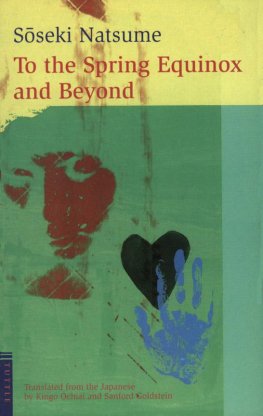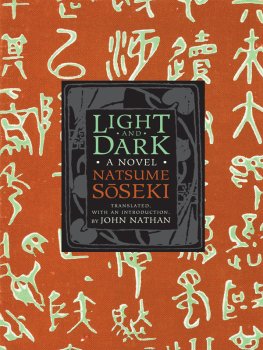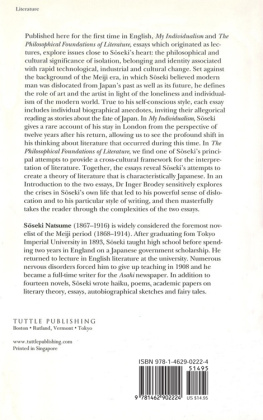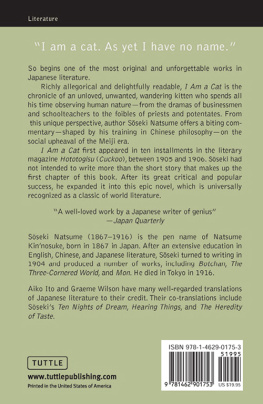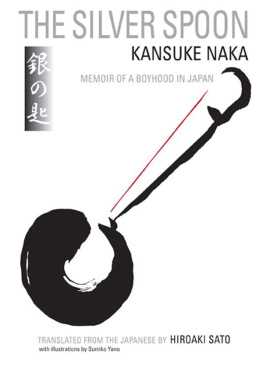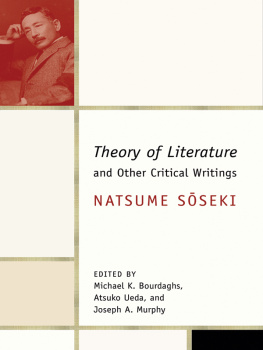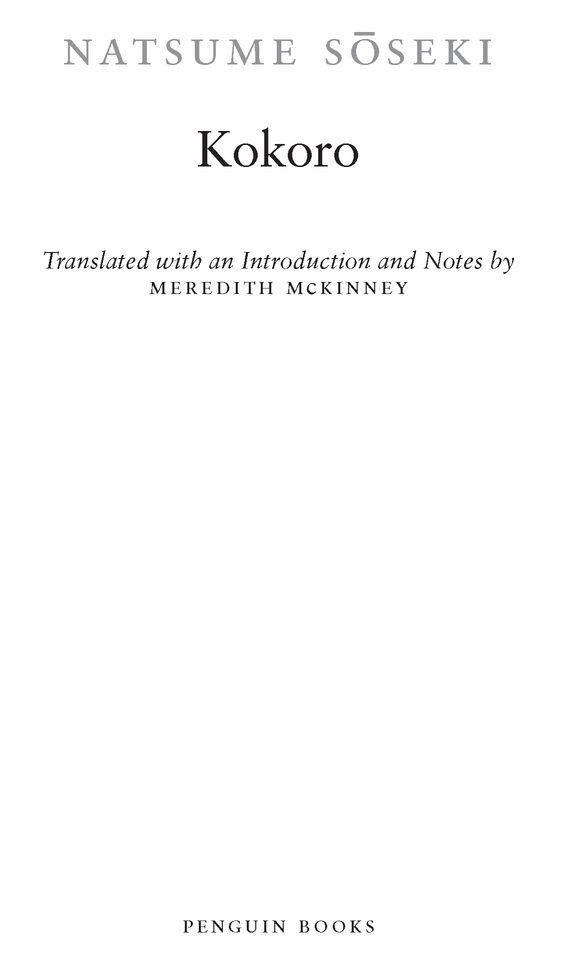Table of Contents
KOKORO
NATSUME SSEKI (1867-1916), one of Japans most influential modern writers, is widely considered the foremost novelist of the Meiji era (1868-1912). Born Natsume Kinnosuke in Tokyo, he graduated from Tokyo University in 1893 and then taught high school English. He went to England on a Japanese government scholarship, and when he returned to Japan, he lectured on English literature at Tokyo University and began his writing career with the novel I Am a Cat. In 1908 he gave up teaching and became a full-time writer. He wrote fourteen novels, including Botchan and Kusamakura, as well as haiku, poems in the Chinese style, academic papers on literary theory, essays, and autobiographical sketches. His work enjoyed wide popularity in his lifetime and secured him a permanent place in Japanese literature.
MEREDITH McKINNEY holds a Ph.D. in medieval Japanese literature from the Australian National University in Canberra, where she teaches at the Japan Centre. She taught in Japan for twenty years and now lives near Braidwood, New South Wales. Her other translations include Ravine and Other Stories by Furui Yoshikichi, The Tale of Saigyo, and, for Penguin Classics, The Pillow Book of Sei Shnagon and Natsume Ssekis Kusamakura.
Introduction
Natsume Ssekis Kokoro was published in 1914, two years before his death at the age of forty-eight. Sseki, even then widely acknowledged as Japans leading novelist, was at the peak of his writing career, and Kokoro is unquestionably his greatest work. Today it is considered one of Japans great modern novels, known to every schoolchild and read by anyone serious about the nations literature.
The reasons for Kokoros importance lie not in its literary quality alone. Sseki was a superb chronicler of his time, and Kokoro cannot be fully understood without some knowledge of the world from which it sprang.
Japans Meiji period (which ended with the emperor Meijis death in 1912) began in 1868 with the tumultuous overthrow of the old Tokugawa shogunate, which had ruled Japan unopposed for 250 years. The shift signaled far more than a change of power. Japan under the Tokugawas had been rigidly feudal and isolationist, a Confucian society cut off from the changes that were rapidly overtaking much of the rest of the world. Pressure from Western nations eager to expand their sphere of trade finally proved irresistible in 1853, when the commander of a U.S. squadron, Matthew Perry, anchored his black ships threateningly offshore and sent an ultimatum to Japans ruling powers. The subsequent internal upheaval resulted in a new government that opened Japans doors to the West and embraced the introduction of Western culture and technology. In the next four decades Japan was utterly transformed. The Meiji period is synonymous with the fundamental transformation that set Japan on the road to becoming all that it is today.
Such rapid change inevitably comes at a psychological cost, and this is what Sseki acutely documented in his finest novels. The dilemmas that he portrayed were deeply felt. Natsume Kinnosuke (Sseki was his nom de plume) was born in 1867, the year before the Meiji era began, in what was still known as Edo (now Tokyo). The old Japan was his inheritance in more than birth. He was educated in the Chinese and Japanese classics and in the Confucian moral code, which Western concepts of individualism and individual rights were only just beginning to undermine. Kokoros central character, the man referred to as Sensei, is of an age with Sseki, and his references to the importance of his old-fashioned moral education clearly reflect Ssekis own experience. For both, the Meiji periods embrace of Western individualism provoked irreconcilable inner conflicts that haunted them through life.
Kokoros Sensei shares other characteristics with Sseki as well. Family difficulties and alienation, a recurrent theme in many of Ssekis novels, played their part in his own early life. A late child of a large family, Sseki as an infant was formally adopted by a childless couple; his real family took him back only grudgingly when the couple divorced nine years later. Adoption, which plays an important part in the story of Senseis friend K in Kokoro, was common at the timecontinuing the family name was more important than maintaining blood ties. Ssekis own adoption was a sorry failure on every level, leaving him feeling unloved, isolated, and bitter.
Like Kokoros Sensei, Sseki, a bright student, attended the new university in Tokyo, where he specialized in English literature. Meiji-era Japan believed that foreign literature held the key to understanding the Western culture that it was then avidly embracing, and Sseki was part of the earliest generation to be trained in this important field. His education gave him elite status, and in 1900 the Japanese government selected him to spend two years studying in London; the intention was that he would increase the nations cultural capital by bringing back a deeper understanding of the West. But Sseki was miserable in England, isolated and alienated from everything around him, which seems to have brought him close to nervous collapse. After his return to Japan, he took up prestigious teaching posts at the First National College and in the English literature department at Tokyos Imperial University. To all appearances, he was set to rise to the top of his elite profession.
But Sseki could revel in neither his status nor his success. Like Kokoros Sensei, he was an essentially introverted and retiring person; his nervous sensibility shrank from exposure to the everyday world, and the strain of teaching told badly on his nerves. Partly to soothe and entertain himself, he decided to try his hand at a light, humorous novel (I Am a Cat, 1905). To his surprise, upon publication it achieved instant fame. A year later came two more novels: the immensely popular Botchan (1906) as well as the beautiful haiku-style Kusamakura. At the age of forty, encouraged by the Asahi newspapers guarantee to serialize any future work, Sseki took the audacious step of resigning from his teaching posts and devoting himself to his writing.
His novels had moved from gently humorous anecdotes and observations of life to the more philosophical and experimental approach of Kusamakura, which maintains a delightful lightness of touch even as it engages thoughtfully and critically with Meiji Japans transformations and its fraught relationship to Japans past. But the mature works that now began to flow from his pen struck a new, more inward note. Sseki became increasingly focused on his contemporaries quintessential experience, one that he himself felt acutely: the necessity to evolve a modern, individual sense of self and to cope with the new Meiji selfs resultant problems: isolation, alienation, egotism, and profound dislocation from its cultural and moral inheritance. Sseki increasingly sought to portray for his readers not only the upheavals of their rapidly changing world but the dilemmas and suffering of the contemporary psyche.
These themes achieved their ultimate statement in the late novel


